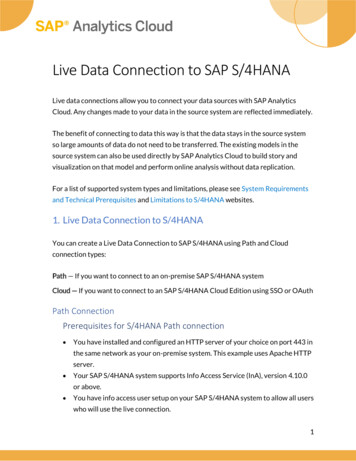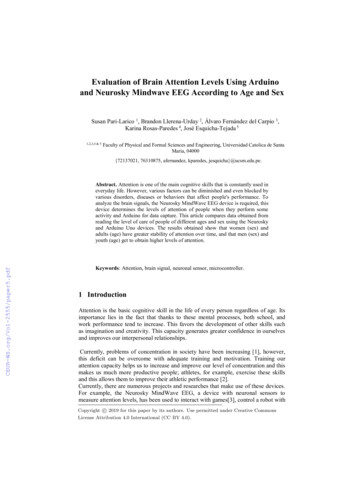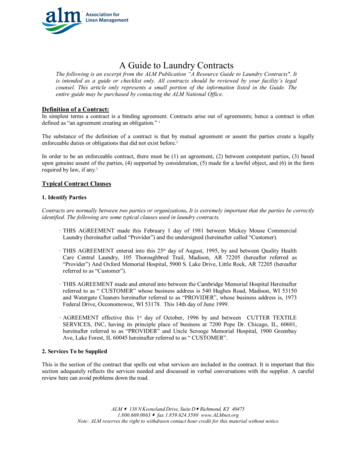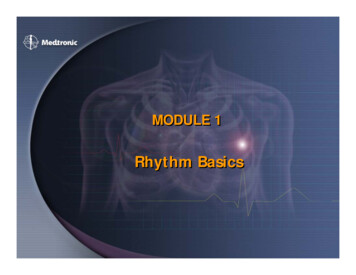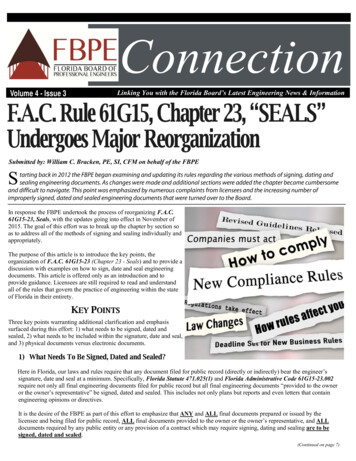
Transcription
ConnectionVolume 4 - Issue 3Linking You with the Florida Board’s Latest Engineering News & InformationF.A.C. Rule 61G15, Chapter 23, “SEALS”Undergoes Major ReorganizationSubmitted by: William C. Bracken, PE, SI, CFM on behalf of the FBPESIn response the FBPE undertook the process of reorganizing F.A.C.61G15-23, Seals, with the updates going into effect in November of2015. The goal of this effort was to break up the chapter by section soas to address all of the methods of signing and sealing individually andappropriately.The purpose of this article is to introduce the key points, theorganization of F.A.C. 61G15-23 (Chapter 23 - Seals) and to provide adiscussion with examples on how to sign, date and seal engineeringdocuments. This article is offered only as an introduction and toprovide guidance. Licensees are still required to read and understandall of the rules that govern the practice of engineering within the stateof Florida in their entirety.KEY POINTSThree key points warranting additional clarification and emphasissurfaced during this effort: 1) what needs to be signed, dated andsealed, 2) what needs to be included within the signature, date and seal,and 3) physical documents versus electronic documents.1) What Needs To Be Signed, Dated and Sealed?Here in Florida, our laws and rules require that any document filed for public record (directly or indirectly) bear the engineer’ssignature, date and seal at a minimum. Specifically, Florida Statute 471.025(1) and Florida Administrative Code 61G15‐23.002require not only all final engineering documents filed for public record but all final engineering documents “provided to the owneror the owner’s representative” be signed, dated and sealed. This includes not only plans but reports and even letters that containengineering opinions or directives.It is the desire of the FBPE as part of this effort to emphasize that ANY and ALL final documents prepared or issued by thelicensee and being filed for public record, ALL final documents provided to the owner or the owner’s representative, and ALLdocuments required by any public entity or any provision of a contract which may require signing, dating and sealing are to besigned, dated and sealed.(Continued on page 7)
F.A.C. Rule 61G15, Chapter 23, “SEALS” Undergoes Major Reorganization(Continued from page 1)In addition, part of this effort focused on clarifying references to “documents” within the rule toinclude: plans, prints, specifications, reports or other documents. These clarifications can be foundwithin Section 61G15-23.001, F.A.C.- Signature, Date and Seal Shall Be Affixed which addressesin detail what needs to be signed, dated and sealed.In a number of cases, licensees, much to their detriment, failed to sign, date and seal documentssimply because their client didn’t require it. Even if a licensees’ client doesn’t require a documentto be signed, dated and sealed, the licensee is required to sign, date and seal it if the rules require it.Confusion also occurs with the term “filed for public record.” In a number of other cases, licenseeshave failed to sign, date and seal documents because the document was not intended to be filed forpublic record. Again, licensees are required to sign, date and seal all documents required by rulewhich include far more than those simply intended to be filed for public record.2) What Needs To Be Included Within The Signature, Date and Seal?“Many licenseeswithin the State ofFlorida fail tounderstand that thedate a document issigned MUST beincluded for bothphysical andelectronicdocuments.”Many licensees within the State of Florida fail to understand that the date a document is signedMUST be included for both physical and electronic documents. In the case of physically transmitted documents, the licensee’ssignature is required to be overlapping and partially obscured by the seal (so as to verify the authenticity of the signature), not“below” the seal on the page.Sections 61G15-23.003 through 61G15-23.005 address in detail what needs to be included within the signature, date and seal.Note: A scanned, facsimile, digitally created or copied image of the licensee’s signature IS STILL NOT allowed to be usedon original signed, dated and sealed documents.3) Physical Documents vs. Electronic DocumentsSimply put, the issue of physical documents versus electronic documents can be summed up as:Once a physical document - always a physical document.Physical documents must be physically signed, dated andsealed.Once an electronic document - always an electronicdocument. Electronic documents must be eitherelectronically or digitally - signed, dated and sealed.While an electronic (scanned) copy of a physically signed,dated and sealed document is suitable for archival purposes,IT IS NOT considered to be an original signed, dated andsealed document. In order for the electronic (scanned) copy ofa physical document to be considered legitimately signed,dated and sealed, the electronic (scanned) copy MUST be resealed electronically or digitally.Likewise, the printed copy of an electronic document issuitable for archival purposes but IT IS NOT considered to bean original signed, dated and sealed document. In order for the printed copy of an electronically signed, dated and sealeddocument to be considered legitimately signed dated and sealed it MUST be physically signed, dated and sealed.Section 23.003-Procedures for Physically Signing and Sealing Plans, Specifications, Reports or Other Documents addressesin detail how to sign, date and seal physical documents. While, Section 23.004-Procedures for Digitally Signing and SealingElectronically Transmitted Plans, Specifications, Reports or Other Documents addresses in detail how to digitally sign, dateand seal electronic documents and Section 23.005-Procedures for Electronically Signing and Sealing ElectronicallyTransmitted Plans, Specifications, Reports or Other Documents addresses in detail how to electronically sign, date and sealelectronic documents.(Continued on page 8)7
F.A.C. Rule 61G15, Chapter 23, “SEALS” Undergoes Major Reorganization(Continued from page 7)ORGANIZATION OF CHAPTER 23Below is the outline reflecting the current organization of Chapter 23: 61G15-23.001 - Signature, Date and Seal Shall Be Affixed 61G15-23.002 - Seals Acceptable to the Board 61G15-23.003 - Procedures for Physically Signing and Sealing Plans, Specifications, Reports or Other Documents 61G15-23.004 - Procedures for Digitally Signing and Sealing Electronically Transmitted Plans, Specifications, Reportsor Other Documents 61G15-23.005 - Procedures for Electronically Signing and Sealing Electronically Transmitted Plans, Specifications,Reports or Other DocumentsTo view Chapter 23 in its entirety since being revised go to our website at www.fbpe.org and select Statutes and Rules under theLegal section or access the following link, ules.HOW TO SIGN, DATE AND SEAL ENGINEERING DOCUMENTSPlacement of the date is required regardless of whether the document is physically or electronically transmitted. The signature andseal however vary according to whether the document is physically or electronically transmitted. Dating DocumentsBoth physically and electronically transmitted documents require the date that the signature and seal is affixed be placedimmediately adjacent to the signature. However, it is not required to be placed beneath the seal.61G15-23.001(4)(d) The date that the signature and seal is affixed as provided herein shall beentered on said plans, prints, specifications, reports or other documents immediately adjacent tothe signature of the professional engineer. Signing and Sealing Physically Transmitted DocumentsPhysically transmitted documents require that the licensee create by hand an original of the licensee’s signature. A scanned,facsimile, digitally created or copied image of the licensee’s signature is not allowed.61G15-23.003(1) The licensee shall sign by hand an original of the licensee’s signature on eachpage required to be sealed. A scanned, facsimile, digitally created or copied image of thelicensee’s signature shall not be used.As for creating the seal, physically transmitted documents are allowed to be embossed, contain a digitally created seal orsealed using a wet stamp. In each of these cases the seal is to be placed partially overlapping the licensee’s signature suchthat the signature is not made illegible.61G15-23.003(2) The licensee must then use a wet seal, a digitally created seal, or anembossing seal placed partially overlapping the licensee’s signature on each page requiredto be sealed. The placement of the seal shall not render the signature illegible.Acceptable Examples(Continued on page 9)8
F.A.C. Rule 61G15, Chapter 23, “SEALS” Undergoes Major Reorganization(Continued from page 8) Signing and Sealing Electronically Transmitted DocumentsSimilar to physically transmitted documents, electronically transmitted documents are required to contain the date they weresigned and sealed (located immediately adjacent to where the signature would appear) and are permitted to have a digitallycreated seal. However, electronically transmitted documents are prohibited from including a scanned or digitally createdimage of the licensee’s signature.Furthermore, unlike physically transmitted documents, electronically transmitted documents are required to contain astatement clearly indicating that the document has been electronically signed and sealed (located immediately adjacent towhere the signature would appear) and that printed copies of the document are not considered signed and sealed. This isrequired so that the recipient of a printed copy of an electronically transmitted document will know that the printed copy isnot an original signed and sealed copy.As for signing and sealing, electronically transmitted documents are considered to be signed and sealed by virtue of the factthat the licensee has electronically “locked” the document, thereby preventing any changes from being made withoutcorrupting the document and more importantly without the licensees’ knowledge. Electronically transmitted documents canbe “locked” (or signed and sealed) by one of two methods: 1) digital signing and sealing, or 2) electronic signing andsealing.1) Digital Signing and SealingDigital signatures are typically provided by a third party and are used to electronically lock documents. When using adigital signature, the licensee is required to have their identity authenticated by a certification authority and to assurethat the digital signature is:a)b)c)d)Unique to the person using it;Capable of verification;Under the sole control of the person using it; and,Linked to a document in such a manner that the digital signature and the corresponding document can bedeemed invalid if any data in the document is changed.After opening a legitimately digitally signed and sealed document, the viewing screen will show a colored text bar onthe screen indicating the “authenticity of the signature”. If this bar does not appear or the text within the bar indicatesthat there is a problem with any of the signatures then the document has not been or is no longer legitimately signed andsealed.Below is an example of what should appear to indicate that the document has been legitimately digitally signed andsealed. In this example, the blue bar across the top of the document with the text: “Signed and all signatures are valid”indicates that it is valid and has not been altered since it was signed and sealed.Below is an example of what would appear to indicate that the document has not been legitimately digitally signed andsealed. In this example, the blue bar across the top of the document stating that “At least one signature requiresvalidating” indicates that the document is not valid or may have been altered since it was signed and sealed.(Continued on page 10)9
F.A.C. Rule 61G15, Chapter 23, “SEALS” Undergoes Major ReorganizationContinued from page 9)Of equal importance is what is required within the document where a signature would normally appear. Within thedocument, if a digitally created seal is used, the seal along with the required text is to appear where the signature wouldnormally appear.Acceptable ExampleWithin the document, if a digitally created seal is not used, the required text is to appear where the signature wouldnormally appear.Acceptable Example[Licensee] State of Florida, Professional Engineer, License No. XThis item has been electronically signed and sealed by [Licensee, PE]on [DATE] using a Digital Signature.Printed copies of this document are not considered signed andsealed and the signature must be verified on any electronic copies.2) Electronic Signing & SealingElectronic signatures are also used to electronically lock documents but do not require third party verification. However,because this method does not require third party verification, it does involve a multi-step process aimed at protecting theintegrity of the document.In short, licensees are required to create a “signature” file and a “signature” report. The “signature” file is the file thatcontains the document(s) to be electronically signed and sealed (locked) for submittal. The “signature” report is asingular document intended to summarize what is in the “signature” file and is being electronically signed and sealed.This report is required to include a brief overall description of the engineering document(s) being signed and sealedalong with the SHA-1 authentication code(s). NOTE: A SHA-1 authentication code in cryptography, is a cryptographichash function that produces a “message digest” or “hash value” (hexadecimal number) that is used to protect sensitiveinformation.Once the “signature” file and the “signature” report have been created, the “signature” report is to be printed out,signed, dated and sealed following the procedures for physically transmitted documents. The original “signature”report is then to be transmitted along with the “signature” file. The “signature” file is considered to be signed andsealed if the “signature” file’s SHA-1 authentication code(s) match the authentication code(s) on the manually signed,dated and sealed “signature” report.(Continued on page 11)10
F.A.C. Rule 61G15, Chapter 23, “SEALS” Undergoes Major Reorganization(Continued from page 10)NOTE: Previously the rule allowed a scanned copy of the signed and sealed “signature” report to be transmitted withthe “signature” file provided the licensee maintained a hardcopy of the physically signed and sealed “signature”report in accordance with Rule 61G15-30.009, F.A.C. However, the option to transmit a scanned copy of the“signature” report with the “signature” file was inadvertently omitted during the reorganization process. The FBPEstill recognizes this option and is in the process of adding it back into the rule.The method of creating an electronic signature found in the previous rule was kept in its entirety and can be foundwithin 61G15-23.005(2)(a) through (2)(d), F.A.C. This method was written specifically to support the use of theFlorida Department of Transportation’s (FDOT) PEDDS program and while confusing, actually describes thefunctionality of the PEDDS program. Further, the FBPE understands that while the FDOT has stopped using andsupporting the PEDDS program, other municipalities have adopted it and are currently using it.NOTE: Rule 61G15-23.005 will be further modified by the FBPE so as to provide non-PEDDS specific languageregarding electronically signing and sealing within the rule.Of equal importance is what is required within the document where a signature would normally appear. Within thedocuments themselves, if a digitally created seal is used, the seal along with the required text is to appear where thesignature would normally appear.NOTE: The rule as published inadvertently omitted the graphic examples for this case and the FBPE is in the processof adding it back into the rule.Acceptable ExampleWithin the documents themselves, if a digitally created seal is not used, the required text is to appear where thesignature would normally appear.Acceptable Example[Licensee] State of Florida, Professional Engineer, License No. XThis item has been electronically signed and sealed by [Licensee, PE]on [DATE] using a SHA-1 authentication code.Printed copies of this document are not considered signed andsealed and the SHA-1 authentication code must be verified on anyelectronic copies.The most recent version of Florida’s Statutes and Administrative Code as it relates the practice of engineering can be foundon FBPE’s website at ules or by selecting the Statutes and Rules pageunder the Legal section of www.fbpe.org. If you have any questions or require further clarification to the changes to F.A.C.Rule 61G15-23, you can contact someone in our Legal Department at 850-521-0500, or send an email to board@fbpe.org.11
1) Digital Signing and Sealing . Digital signatures are typically provided by a third party and are used to electronically lock documents. When using a digital signature, the licensee is required to have their identity authenticated by a certification authority and to assure that the digital

